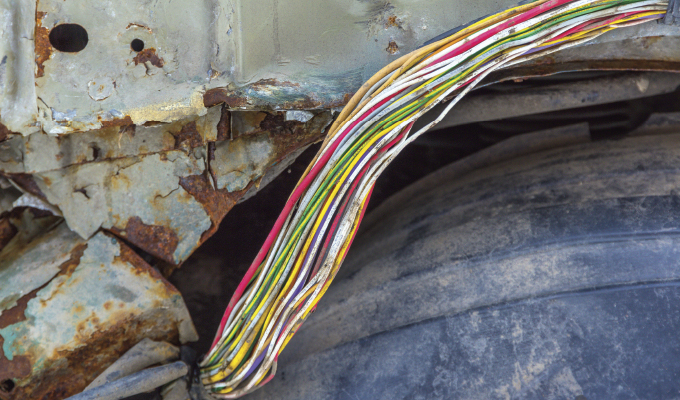Every business experiences truck downtime, which can be challenging for businesses relying on trucking for transportation and logistics. Many downtime issues are usually the result of ground wire problems. While downtime can cost a business in terms of productivity, there are other problems that can arise including safety concerns, maintenance costs, and supply chain disruptions – meaning it’s critical to get trucks back into service as soon as possible.
To do so, it’s important to note: what exactly is a bad ground?
A bad ground is a ground wire or circuit with more resistance than normal due to corrosion (oxidation) in the wiring harness or pin connections. Corrosion occurs when there’s a break in wire insulation or faulty connector seals, which leads to an even bigger issue on today’s trucks, especially when everything is computer controlled or monitored with an electronic control unit (ECU). Further compounding the problem is water infiltration along the wire, affecting critical components like ECUs.
Problems can occur at any time, whether a new truck that has just rolled off the factory line or a used truck with 250,000 miles. Since these wires are like small pipes, water can make its way into a break in the wire insulation or a faulty seal, “infecting” everything in its path. If the problem is higher in the harness, gravity will work to its benefit.
IDENTIFYING GROUNDING
There are a host of issues that can cause grounding problems such as improperly installed aftermarket equipment, an unsecured, overly secured, or stretched harness, vibration of the diesel engine, tightly installed factory zip ties, corrosion, resistance, or issues with ECU communications.
Signs of corrosion are easy to identify. Look for either light green deposits or a light film on the pin connections. Grounding issues can be identified in the high resistance values between the truck cab and the frame and between the frame and the engine. Anything over .3 ohms could cause problems.
While it can be easy to identify the problems, making a diagnosis can be more complex due to communication issues between the ECUs. There are two different data links throughout the truck: the J1939 control link and the J1587/1708 info link. The wire sends information back to the instrument cluster (e.g., diagnostic trouble codes (DTC), vehicle speed, ABS wheel speed, engine pressures, temperatures). The J1939 control link should have a sustained reading of 60 ohms—if not, then there is a problem in the circuit or terminating resistor.
TROUBLESHOOTING
When troubleshooting electrical ground problems, look to the truck’s wiring schematic, which provides wire/circuit numbers, connector locations, pin locations, and wire colors. Late model truck clusters display the DTCs and other specifics to help with in-depth troubleshooting.
For example, an electrical fault or mechanical fault, voltage high, voltage low, circuit shorted high, circuit shorted low, data erratic, or communication error are all descriptions linked to certain fault codes. These make it easier for diagnostics to be performed. Those codes also help determine which function to use on a digital multimeter when looking to identify that problem.
The most frequent grounding problems are high resistance values between the truck cab and the frame and between the frame and the engine.
Most problems can be determined by process of elimination:
- Check fuses first: if the fuses check out, then check what the wire is controlling (e.g., light, sensor, motor).
- Next, check the circuit to make sure the wires are not damaged and have good continuity. (There are miles of wires and plenty of potential problems areas).
- If this area checks out, move on to the beginning of the circuit (e.g., ECU, switch).
Sometimes the problem can’t be traced or duplicated. Variables that affect troubleshooting “invisible” problems include temperature, pressure, and vibration. Some faults can be found by connecting a digital multimeter and wiggling the harness to see if there is a jump, dip, or complete loss in voltage, the latter indicating an open circuit.
When a problem does occur, by following the tips outlined above, you can be assured of a well-grounded truck for reliable performance and improvements in vehicle uptime.
For More Information
Founded in 1948, Fluke Corporation is a global leader in compact, professional electronic test tools. To learn more, visit www.fluke.com.




